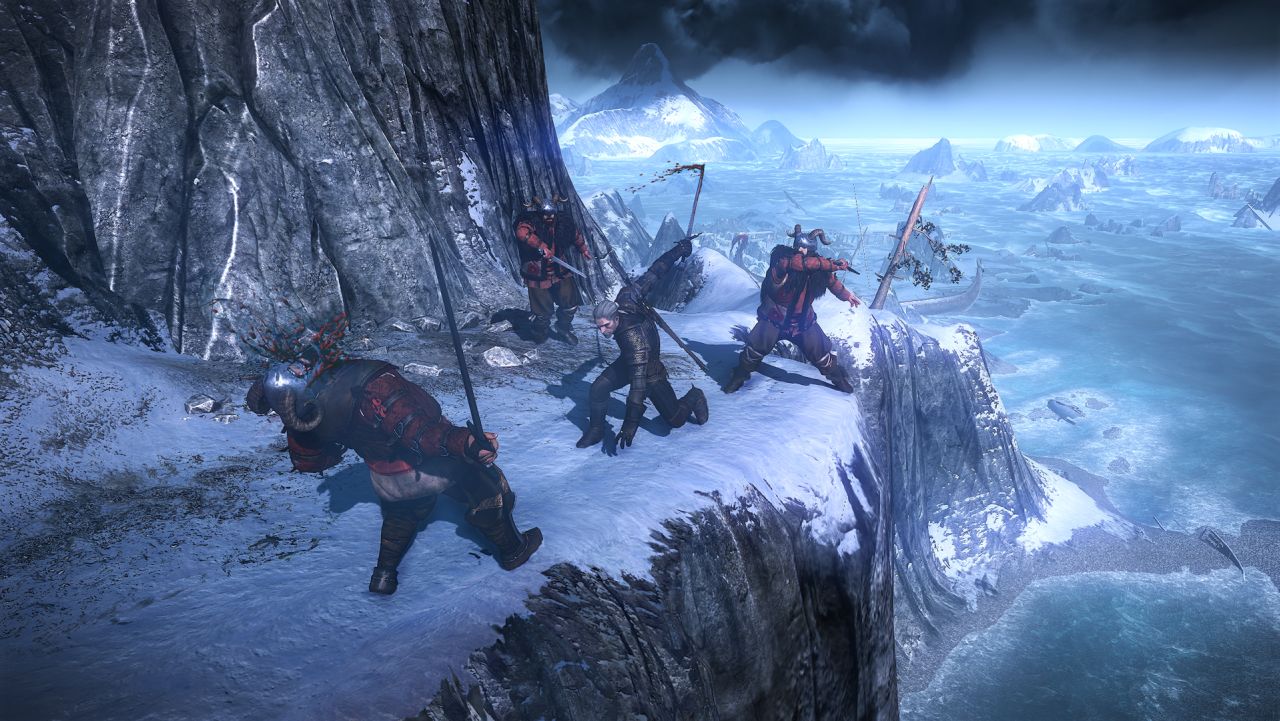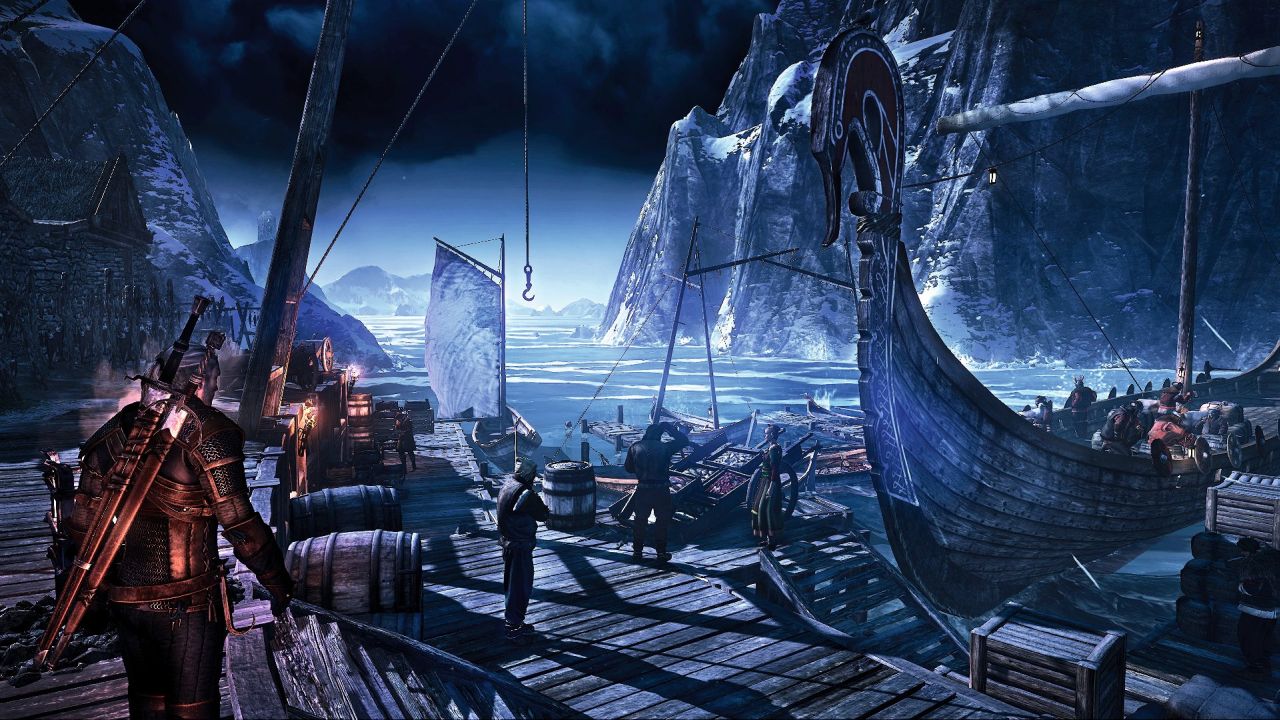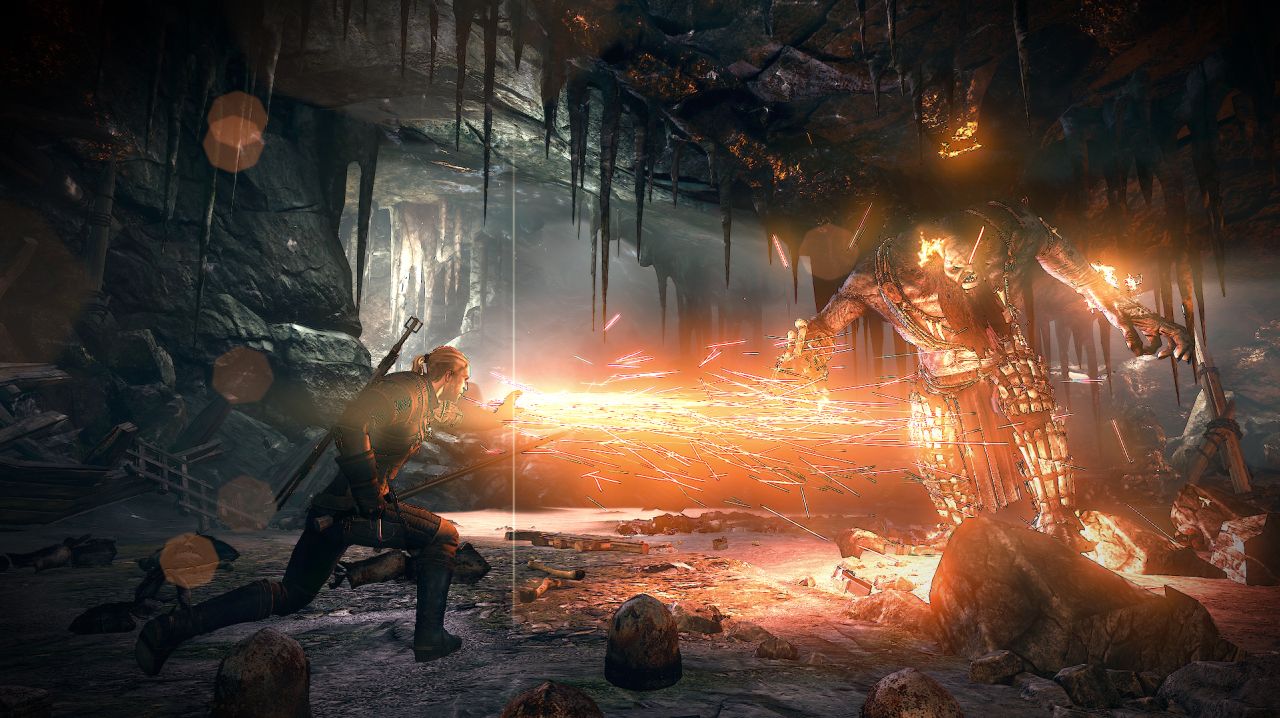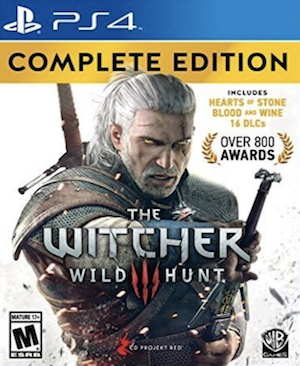
The Witcher 3: Wild Hunt is the latest – and if this interview is any indication, the last – edition of the series based on the books by Andrzej Sapkowski and developed by CD Projekt RED. There’s still a lot about the game we don’t know – which is why we sat down with quest designer Pawel Sasko to find out more about what makes The Witcher 3 so sublimely awesome (hint: a lot of things).
Ravi Sinha: Considering the amount of hype that it generated, superseding CD Projekt RED’s other big project Cyberpunk 2077, how did you manage to keep it under wraps for this long?
Paweł Sasko: I work as a game developer and know very little about PR and marketing. We have a small department of dedicated and talented miracle-mongers who know how to do such things. As a complete greenhorn, I can say that the hype generated around Cyberpunk 2077 served well as a distraction.
Thanks to that, we had time to prepare what we needed to confirm what some players had suspected for a long time – that we are creating the next-generation RPG, The Witcher 3.
"We are aiming for the title of prettiest RPG of all time."
- Paweł Sasko, Quest Designer, The Witcher 3: Wild Hunt
Ravi Sinha: Initial reactions for the screenshots have been great, but we were surprised to hear they’re from an older version of the game. With DirectX 11, will we be seeing visuals that surpass the current crop of next generation games like Crysis 3?
Paweł Sasko: It all comes down to the fact that CD Projekt RED loves challenges. With tunnel-like, linear levels created by a talented team, it’s relatively easy to deliver eye-candy graphics, because it’s always clear where player is looking. But when the game has the size of The Witcher 3, it becomes an incomparably bigger challenge and this is what makes our artists totally excited.
Screenshots that we’ve shown are from an old build of the engine that ran using a dated renderer. Much of it is already rewritten and judging from the effects, we are aiming for CG quality of in-game graphics.
But this is not only an achievement of our programmers. Our art team is one of the best staffed departments in the company, mostly because the men and women involved have been with CD Projekt RED since the beginning of The Witcher 1.
We also know that in many cases with canny art direction, it’s possible to do more than using monstrous textures and having them loaded and displayed flawlessly. We are aiming for the title of prettiest RPG of all time.

Ravi Sinha: What was it like developing for next generation consoles like the PlayStation 4? What kind of advantages does it present over the PC?
Paweł Sasko: After the announcement of the PS4 many graphics programmers commented that Sony’s upcoming console is a high-end PC and I agree with them. The change of architecture made a lot of developers happy, including us.
From a technical standpoint, the biggest disadvantage of PCs is customizing hardware in an almost infinite number of ways. That’s why working on PS4 gives us comfort that every gamer is going to have a quality time with The Witcher 3.
Ravi Sinha: How come you chose to reveal The Witcher 3 separately and not at Sony’s main PlayStation 4 reveal event where the whole world would be watching?
Paweł Sasko: It was obvious for us that the reveal of a new console was a great moment to show our game. But on the other hand, the most important thing about the whole event was PS4 and its features. As we expected, all the games and console itself dragged out the player’s attention from everything else.
The Witcher 3 is our beloved child and we want the world to know how good the game will be. It might have been a bit too difficult to get the attention of gamers while so many good titles were being announced during Sony’s press conference. So we chose to show the game separately.
Ravi Sinha: What’s the good word on Witcher 3 for that “other” next gen console? And no, we don’t mean the Wii U.
Paweł Sasko: I don’t want to spoil any surprises that console manufacturers have prepared for players – ask them. I can only confirm that the game will be present on all high-end platforms by the end of 2014.

Ravi Sinha: The Witcher 3 will feature a main quest and several side stories that interlink with it to offer different play through experiences. Can you give us any examples of the same?
Paweł Sasko: The Witcher games have always been about the story and quests and we are very touchy when it comes to spoiling players’ experiences, so I will not say more about that. However, I can reveal a bit of the main story and outline for what The Witcher 3 is about.
As players know, a sterile Witcher does not have any true kin. But Geralt of Rivia managed to build an extremely strong bond with one important woman – a sorceress who was long gone, Yennefer. She was always his true love.
But there is another important person around, very familiar to Witcher fans, Triss Merigold. Geralt is going to finally resolve his relationships and stand to protect those whom he loves. As he moves on, this is his new focus in life. In Geralt’s morally ambiguous life there was not too much space for his beloved ones, but that is going to change.
"We are using every trick that we know to encourage players to explore and keep that activity rewarding, even for the smallest discoveries. "
Ravi Sinha: Will we be looking at multiple endings or even different end-bosses?
Paweł Sasko: This game is the conclusion of the trilogy of Geralt of Rivia and we want players to be satisfied. That’s why we’ve invested a lot of time and energy into crafting multiple endings. There are three completely different closing sequences, each a few hours long, while the whole world at the end is going to be in one of 36 different states, derived from player’s choices through the game.
We have no such thing as bosses in our game, but there are plenty encounters with huge opponents and important foes for the storyline. All of them have unique abilities and attacks, but unlike in The Witcher 2, everything here is based on RPG systems. We listened to fan feedback and learned that introducing completely new mechanics for boss battles is not good design decision. This also means no QTE gameplay that detracts from what people should expect from a deep RPG.
Ravi Sinha: The setting is pretty different from other Witcher games, and boasts a world 30 times the size of Witcher 2. What kind of challenges did you face in designing this world, and how did you go about solving them?
Paweł Sasko: When you have a properly staffed level design department, creating a huge open world is not a hard task. But filling it with high-quality, story-driven content – that is what makes it challenging. Pretty vistas are not what make a game an RPG. So we are doing what we are best at; making memorable characters involved in hand-crafted quests. Our level designers are supporting us greatly.
In their room, there is a huge motto, “Quest or new adventure?” that drives all their work. Our goal is clear: create a lot of “points of interest” and place them in a way so that the player traveling through the lands always sees at least two of them on the horizon, possibly in two different directions. There has to be a small quest telling the story of the location, characters or anything else that builds up the atmosphere of the whole region.
We are using every trick that we know to encourage players to explore and keep that activity rewarding, even for the smallest discoveries. We have tested it hundreds of times already and it seems that we are heading in the right direction.

Ravi Sinha: Will we see more expanded aspects of the sailing? Maybe some other marine missions like hunting those whales we keep seeing or deep sea diving for sunken ships?
Paweł Sasko: One of the most basic goals for The Witcher 3 is to make the player feel and think like the Witcher. That’s why we are introducing a new mechanic called Monster Hunting and giving players the opportunity to mount a horse. Geralt is a professional monster slayer, but not a sailor. He was never like this in the books and two previous games, so we don’t want to change it. We simply can’t imagine him chasing fish.
However, sailing is an important activity of The Witcher 3 and it’s essential for exploring some regions. On the technical side, the boat is fully simulated, reacts to wind and simulation of ocean and waves. It’s a real pleasure to use it for exploration, but we are planning to do even more. Right now we are testing some gameplay opportunities on the working prototype connected to sailing, but I can’t reveal anything more.
Ravi Sinha: For that matter, what kind of quests will we be seeing in Witcher 3? Will it be one elaborate set-piece after another, a more personal mix or a combination of both?
Paweł Sasko: This is a gigantic topic and since I’ve spent a huge part of my life building quests, I could talk about it for days. That’s why I will only mention what is the most important goal for us. All games from The Witcher franchise are story-driven and even the small events have logical reasons and build up to consequences.
The thing that adds emotional weight to a quest is “choice”, defined as an opportunity for player to have an impact on characters and world. It can’t be “good” or “bad” – it has to be always grey and none of the solutions can look like an obvious choice.
We are also very careful when it comes to creating characters. It is important to remember that all the small actions that a character takes (lines he says, voiceover, animations) are building up a gamer’s opinion about the NPC. There are hundreds of rules that we are using while writing characters, but a few are insanely important: a character has to be trying to achieve and do more than he is capable of, and he has to change in the course of the game.
Another important thing is the atmosphere of quests. A lot of less experienced quest designers mix up elements that make the quest both comedy and tragedy. When designer is trying to use all the different narrative styles, it ends up with the quest being a complete mess. We do exactly the opposite. While writing comedy quests, we use humorous elements, create funny situations and dialogs, and make it light-hearted and even silly. But while writing tragedy, we use tools connected to this kind of style – specific writing, dark atmosphere and danger.
We have more rules, but the most important is to have fun while working. I learned after a few years in the industry that if you have fun creating the quest, it is very likely that player will enjoy it even more then you.

Ravi Sinha: Tell us about the non-playable characters in game. How does next-generation technology like the PS4 help in bringing these characters to life?
Paweł Sasko: The appearance of characters is the most significant and easy way to make them distinct and memorable. But it’s costly in terms of processor power. Thanks to next-generation hardware it is possible to render with more polygons, use bigger textures and apply better facial animation and cloth simulation. Characters are literally driving our games, so we are carefully analysing what still can be improved.
"To improve combat, we are introducing new mechanics that allow players to use Witcher senses in combat and exploration. "
Ravi Sinha: What can you tell us about the multiplayer? Can we look forward to competitive multiplayer or something more cooperative?
Paweł Sasko: Game design is a complicated process. We take many elements into consideration, but ultimately uninterrupted gameplay is a priority and will always come first. The Witcher has always been about experiencing your own, unique adventure. One thing is sure – we won’t sacrifice our trademark immersive, single player storytelling for the sake of other features just to have them.
Ravi Sinha: Witcher 3 will take a more tactical approach to fights, as “Geralt’s true mastery comes out in the crowd fights”. Will the system take a more methodical approach compared to Witcher 2’s “arcade” fighting? If so, how does that affect factors like skills and magic?
Paweł Sasko: The combat that players know from The Witcher 2 has evolved. We didn’t change it completely, but improved it greatly in many fields. Now it’s much more tactical, because picking the right strategy against a vicious opponent or group of foes can end the fight quite fast, while using the wrong strategy may end with death.
To improve combat, we are introducing new mechanics that allows player to use Witcher senses in combat and exploration. For instance, while fighting with a wyvern, a player may use Witcher senses to see the poisonous gland and, with one fast thrust, stab it and disable the creature’s poisonous attack. This strategy allows player to block an opponent’s worst attack, but there are many other different options to use Witcher senses.
Ravi Sinha: Has the Witcher 3 team looked at RPGs like Dark Souls or even Dragon’s Dogma and seen any aspects they’d like to incorporate into the game?
Paweł Sasko: Here at CD Projekt RED, we hire people who love playing games. Not only because it’s a pleasure, but also because it creates a library of solutions that a developer can use. Thanks to playing a lot of games, we know what players are used to and we can compare which approach is better.
Horse riding is a good example. You have this feature in Red Dead Redemption, Skyrim, Assassins’ Creed and many other titles. We’ve played all of them and seen which was the most fun and try to improve on that within our own system. In Poland, there is a proverb – “you don’t have to invent the wheel from the beginning”, which means you don’t have to complicate things by designing the basics. In a way it’s like Newton said – we are standing on the shoulders of giants. Many great game designers have come before and standing with them we can reach even further.

Ravi Sinha: Can you tell us a bit more Geralt’s adventure to take on the Wild Hunt and rescue his loved ones? What is about his new enemies that trumps any adversary he’s faced thus far?
Paweł Sasko: This question concerns the core of the storyline and I cannot answer it in detail without getting into spoilers. But as far as old enemies are concerned, you should know that the great war in Witcher 2 changed everything. The Witcher 3 begins after a great invasion and those once powerful have now lost all their might. Those forces which tried to use Geralt for their own ends cannot do it as easily any more. But new players arise in a vacuum, so Geralt will have to cope in this new environment.
"We know the (Witcher) games are successful, but continuing this tale would water down our initial message. "
Ravi Sinha: Aside from the combat and world design, what other areas will The Witcher 3 improve on from its predecessor?
Paweł Sasko: There are two main aspects we improved based on player complaints after the release of The Witcher 2. The first one is the user interface. This time we decided to build a prototype very early and have a unique one for each platform to make sure that it’s convenient. That’s why we can bring back the grid in the inventory for the PC version of the game.
The second thing is the difficulty curve. The game will be challenging – that’s for sure. But the difficulty will rise gradually. You won’t be thrown into deep water at the beginning and the ending will be really demanding.
Ravi Sinha: What aspects of the PlayStation 4’s feature set will we be seeing in the Witcher 3? Will it use the touchscreen on the new DualShock 4 or make use of the SixAxis in any way?
Paweł Sasko: We are pretty excited about features of next-generation consoles and we are carefully examining what we can use and in what kind of way. We would like to use the unique elements of every platform to make sure that the quality of the final game will be really high. For now, I can’t confirm anything more, because at this stage it may not get into the final game.
Ravi Sinha: Considering the sheer scope of the game, it doesn’t seem possible that this will be the end of Geralt’s adventures. As a character, what is it about Geralt that allows for stories like the Witcher 3 to play out? How does he differ from other gaming “heroes”?
Paweł Sasko: Geralt’s legend was planned as a trilogy from the beginning. The story and its coherence are very important for us. We know the games are successful, but continuing this tale would water our initial message.
Ravi Sinha: Any lock on when exactly the Witcher 3 will come out in 2014? And can we expect some gameplay footage at E3 2013?
Paweł Sasko: We have something special planned for E3, so stay tuned.
Thanks to Tom Ohle from Evolve PR for setting this interview up.















